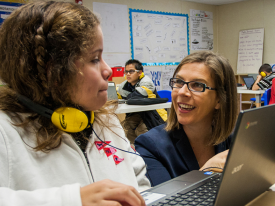How Competency Education Drives Equity
Topics

Together, educators are doing the reimagining and reinvention work necessary to make true educational equity possible. Student-centered learning advances equity when it values social and emotional growth alongside academic achievement, takes a cultural lens on strengths and competencies, and equips students with the power and skills to address injustice in their schools and communities.
Some believe variation in pacing will mean some students get left behind. But in time-based environments, gaps already exist & only grow over time.
This post originally appeared on CompetencyWorks.
Equity is at the heart of competency education. It developed in response to the time-based A-F graded system, which allows students to advance without prerequisite skills and results in harmful variation of proficiency across districts, schools, and teachers. When fully implemented, competency education provides a structure in which proficiency is calibrated to maintain consistency in expectations and students receive adequate instructional supports to progress. Competency education strengthens personalized learning with a transparent structure that enables greater systemic and personal accountability, as well as continuous improvement.
The most frequent concern related about equity to competency education is that some believe variation in pacing will mean a percentage of students get left behind. However, the reality is that in traditional environments, gaps for students who lack core knowledge and skills already exist, and the time-based structure means these gaps only grow over time. What competency education requires is that we focus on students every day, giving them supports to stay on pace and acting to ensure they demonstrate mastery. Students can’t fail an entire course when the unit of correction is each learning target.
In order to ensure that inequitable patterns are not re-created in competency-based schools, leaders will need to attend to several issues. They will need to monitor progress to keep students on pace. They need to hold all students to high levels of rigor. There needs to be a vigilant focus on fighting inequity through a culture of looking for and challenging bias. Schools need to be structured so that struggling students receive rapid, high quality instructional support using the standards to target support.
Most importantly, schools need to develop strategies to meet students where they are so that students reach proficiency in grade level standards by building proficiency in all the pre-requisite skills. Schools must know where every student is in their learning trajectory upon entry and also develop meaningful approaches for students who start off significantly behind grade level. These approaches will recognize that students may have to address social-emotional issues, fill gaps, and, when appropriate, plan for an accelerated trajectory of learning. An additional concern is that students who require more time to learn or are on an accelerated path (i.e., covering a longer segment of the learning progression in the same amount of time) still have the opportunity to develop higher-level skills through deeper learning.
Right now, we are at the cutting edge of understanding the equity challenges in competency education. We are going to need to guard against implementation strategies that create barriers for students. We are also going to want to look for ways to discard our deficit thinking and challenge our assumptions about how school is organized so that we can continue to innovate.
This a reminder to all of us. Competency education isn’t really competency education until we figure out how to get all kids to proficiency.
To learn more, follow this blog series on equity in personalized, competency-based and blended learning. You can find the first blog post here.




